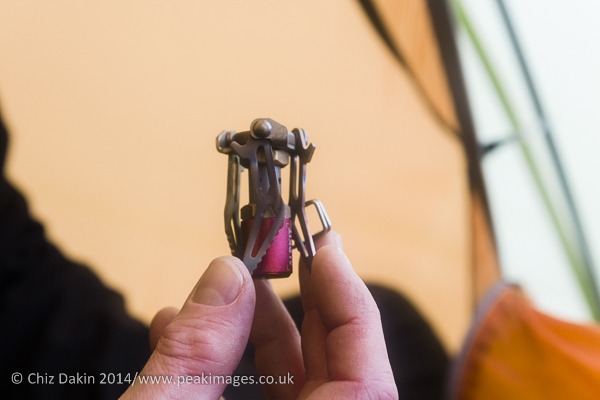 This tiny featherlight stove from Alpkit is a bit like Marmite:
This tiny featherlight stove from Alpkit is a bit like Marmite:
- Either you will be able to cope with its foibles and will love its lack of bulk and weight.
- Or those foibles will drive you to distraction and you’ll hate it regardless of anything else.
I’ve been using this stove since February 2014 with a lot of winter use early on.
Let’s start off with the good points.
 Lightweight.To start with it is seriously light. At 45g (manufacturer’s stated weight) Alpkit claim this is the world’s lightest stove, although as it’s made for Alpkit by Chinese manufacturer FireMaple, it does sometimes turn up under other names. But 45g for the ability to cook dinner is seriously impressive. OK, I know, you have to add fuel and pans to that equation… but by comparison my old remote canister gas cooker weighed a leaden 400g.
Lightweight.To start with it is seriously light. At 45g (manufacturer’s stated weight) Alpkit claim this is the world’s lightest stove, although as it’s made for Alpkit by Chinese manufacturer FireMaple, it does sometimes turn up under other names. But 45g for the ability to cook dinner is seriously impressive. OK, I know, you have to add fuel and pans to that equation… but by comparison my old remote canister gas cooker weighed a leaden 400g.
Small Size. It’s tiny in size too, less than finger length and hides in the palm of even a small hand. 37mm x 52mm folded size.
Cheap. It’s only £25.
Power. Its cooking power is good at 2600W. Or to put it another way, it seems more powerful than my old remote-canister stove (of unknown wattage), and even in winter I’ve not had to wait long enough to be really bored for heating water or reheating rice pouches plus pre-cooked chicken.
So it’s weight and bulk – or lack of – are its seriously good points. Power and price are good too.
What about its foibles?
Well there are a few.
 Directional jets. The jets of blue flame it produces are very vertical in direction. Which means you do have to stir things constantly to make sure that the heat is distributed more evenly through the pan’s contents. It also means that if you lapse on stirring, it’s much more likely that your dinner will stick to the pan. In the worst case scenario that could cost you a small amount of your dinner, but I’ve always noticed the smell before it loses too much. Cleaning the three small areas of burned dinner above each jet position is a bit irritatingly frequent though. Obviously if only used for boiling water, that’s not an issue.
Directional jets. The jets of blue flame it produces are very vertical in direction. Which means you do have to stir things constantly to make sure that the heat is distributed more evenly through the pan’s contents. It also means that if you lapse on stirring, it’s much more likely that your dinner will stick to the pan. In the worst case scenario that could cost you a small amount of your dinner, but I’ve always noticed the smell before it loses too much. Cleaning the three small areas of burned dinner above each jet position is a bit irritatingly frequent though. Obviously if only used for boiling water, that’s not an issue.
Small Switch. The regulator switch is very small and very close to the flame. That said, although it worried me the first few times I used the stove, I’ve not encountered real issue with this in longer-term use – you get used to being careful of hand positioning and making sure loose sleeves are out of the way when switching it on/off/adjusting the power of the flame.
 Stability. This really is the biggy and the one that will polarise most folks. On a 100g gas canister (the smallest one), it really isn’t stable with a 1l pan of water balanced on top. (Note, Alpkit themselves say it isn’t compatible with their 9cm base BrewPot as the arms aren’t long enough to support it, but this may be more to do with the BrewPot’s integrated heat exchanger as no mention is made of this against their 11cm base conventional pan).
Stability. This really is the biggy and the one that will polarise most folks. On a 100g gas canister (the smallest one), it really isn’t stable with a 1l pan of water balanced on top. (Note, Alpkit themselves say it isn’t compatible with their 9cm base BrewPot as the arms aren’t long enough to support it, but this may be more to do with the BrewPot’s integrated heat exchanger as no mention is made of this against their 11cm base conventional pan).
Constant attention (ie holding onto the pan) is essential. Even if you think you’ve got the pan balanced, it can still tip over unexpectedly, with a scary jet of yellow flame shooting horizontally towards the tent porch walls. This potentially is very dangerous – either don’t cook in your porch, or accept the risk and pay extremely close attention to it at all times.
That said, there are ways around this:
- A larger gas canister is more stable, although caution is always required.
- Using a few pegs around the gas canister adds stability.
- In snow, making a snow hole for the gas canister aids stability – although in really cold conditions it won’t help the performance of the gas fuel. Lining the snow hole with tinfoil may well help reduce its cooling effects (Thanks to Richard Hartley for the tinfoil lining tip).
Final thoughts:
So back to Marmite – either you will love the tiny size of the Alpkit Kraku stove and overlook its issues for that, or those issues will make you hate it. I fall into the former category, my husband the latter. So much so that he’s banned it from further use on trips we take together. On the other hand, I’ll still be taking it on solo trips as the weight reduction is worth some inconvenience to me and remote canister stoves don’t come close to the savings in weight and bulk.
Verdict: Mixed opinions, but I think it’s great if weight and bulk are the most important consideration. If stability is a primary concern over weight and bulk, look elsewhere. (Try the Alpkit Koru or Optimus Vega for a remote canister alternative).
(Afternote – I’ve not tried some of the “heavier” 75g canister-top stoves around. It would be interesting to know if they are a better compromise for weight vs stability. However, I do recall stability being somewhat of an issue with the general design of canister-top stoves, even way back when I first got started camping outdoors).

